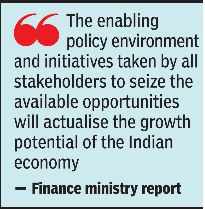
The report said that during this period, the seven-day moving average of daily positive cases had steadily decreased from about 93,000 to 83,000, while the seven-day moving average of daily tests increased from about 1.15,000 to 1.24,000.
“However, the declining positivity rate across India sets the stage to further push the frontiers of economic recovery. To do this, all stakeholders must act as the remaining restrictions on access and mobility are further eased. More than ‘social distancing’ it is ‘self-protection with due precautions’ that fits best in the context of ‘jaan bhi aur jahaan bhi’, ”says the Finance Ministry’s monthly report for September.

He also said that a series of economic data in September points to a steady recovery in almost all sectors, while asserting that with India unlocking every day, the resurgence in demand is palpable in all segments.
“The economic indicators allude to a constant recovery in almost all sectors, with some sectors also shooting above their levels of the previous year. This is despite headwinds of increasing Covid cases in non-metropolitan cities and rural areas and rising food prices. The positive results of the implementation of the Aatmanirbhar Bharat (AB) package and the unlocking of the economy are evident in India’s high frequency real sector indicators for September, ”according to the September Finance Ministry’s monthly economic review.
The Indian economy has been hit hard by the Covid-19-induced lockdown, with GDP falling by almost 24% in the June quarter pointing to a strong contraction for the full year. But the unlocking of economic and other activities that is underway has led to an improvement in most economic indicators, and most show a reduction in the sharp contractions observed in previous months.
The report said that the implementation of the Aatmanirbhar Bharat package and the unlocking of the economy have ensured that the economic recovery in India has gained momentum. This is seen in agriculture, and the production of kharif food grains in 2020-21 is estimated to exceed the previous year’s level.
He said the growth in demand in the rural sector was reflected in the registration of two-wheelers / three-wheelers / passenger cars along with tractor sales reaching / exceeding the previous year’s levels in August. Other high-frequency indicators have also improved in sync with global activity. The increase in global demand has led to the expansion of India’s exports by 5.3% in September on an annual basis. The recovery in rail freight transport allowed earnings to post positive year-on-year growth for the first time since March in August and early September, according to the report.
He said the easing of interstate movement restrictions, quarantine policy and unblocking were also accompanied by the recovery of rail passenger income. Freight traffic volumes continued to move slowly towards the levels of the previous year, reporting an even smaller year-on-year contraction in August. With domestic aviation traffic also increasing, the upcoming holiday months are expected to further fuel growth.
“The sustained spread of the virus poses a downside risk to the growth rate in the short and medium term. To combat these risks, the government has strategically undertaken several important structural reforms that span various sectors. These will strengthen the fundamentals of the economy towards strong and sustainable growth in the long term, ”said the report prepared by the economic division of the department of economic affairs.
“The conducive political environment and initiatives taken by all stakeholders to take advantage of the opportunities available will update the growth potential of the Indian economy.
In its latest review, S&P Global Ratings maintained India’s investment grade credit rating (BBB-) with a stable outlook, as it expects the country’s economy and fiscal position to stabilize and begin to recover from 2021. The India’s likely growth path is visible in this assessment, ”the report said.
.